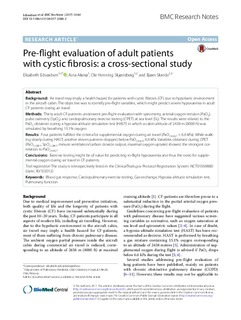Pre-flight evaluation of adult patients with cystic fibrosis: a cross-sectional study
Journal article, Peer reviewed

View/
Date
2017-02-06Metadata
Show full item recordCollections
- Artikler / Articles [2119]
Original version
BMC Research Notes. 2017, 10, doi: 10.1186/s13104-017-2386-2 10.1186/s13104-017-2386-2Abstract
Background: Air travel may imply a health hazard for patients with cystic fibrosis (CF) due to hypobaric environment in the aircraft cabin. The objective was to identify pre-flight variables, which might predict severe hypoxaemia in adult CF patients during air travel. Methods: Thirty adult CF-patients underwent pre-flight evaluation with spirometry, arterial oxygen tension (PaO2), pulse oximetry (SpO2) and cardiopulmonary exercise testing (CPET) at sea level (SL). The results were related to the PaO2 obtained during a hypoxia-altitude simulation test (HAST) in which a cabin altitude of 2438 m (8000 ft) was simulated by breathing 15.1% oxygen. Results: Four patients fulfilled the criteria for supplemental oxygen during air travel (PaO2 HAST < 6.6 kPa). While walking slowly during HAST, another eleven patients dropped below PaO2 HAST 6.6 kPa. Variables obtained during CPET (PaO2 CPET, SpO2 CPET, minute ventilation/carbon dioxide output, maximal oxygen uptake) showed the strongest correlation to PaO2 HAST. Conclusions: Exercise testing might be of value for predicting in-flight hypoxaemia and thus the need for supplemental oxygen during air travel in CF patients.